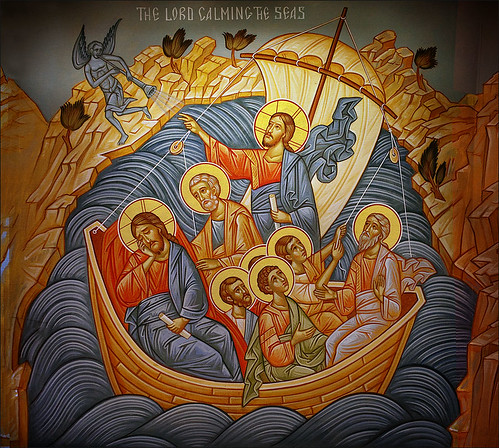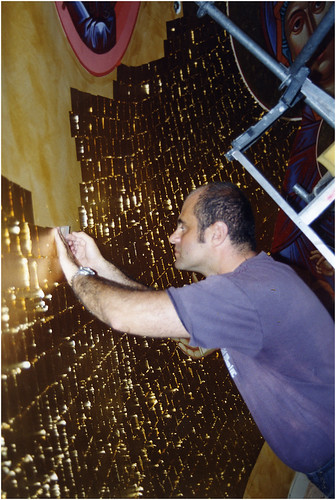Posted in By wanderingval 0 comments
From the discussion between Archimandrite Victor - rector of St. Euphrosyne of Polotsk Church in Karsava, Latvia and Iconographer Archimandrite Zinon.
“In the Moscow Patriarchate Journal, 1989, No. 10, there is an article by L. A. Ouspensky about colors in icons. It explains very simply and convincingly why a colored photograph is unacceptable for use in church: it only imitates color; it has no color of its own. For this reason it cannot serve as a substitute for a painted icon. An icon must witness to the Truth, and here we introduce something false, artificial; this cannot be. Fr. Victor: This is the same as having artificial flowers in church. Patriarch Alexis I asked that they not be brought into church, because there is no truth in them.”
“Tragically, the icon has become a mere illustration of the celebrated event, and for this reason it doesn’t matter what form it takes, because nowadays even photographs are venerated as icons.
Here we will add a few words about the blessing of icons. Very often, seeing a newly-painted icon and desiring to venerate it, people ask: Is it sanctified (osviachshennaya)? This is not an ancient custom. (In the Book of Needs, the rite is called “blessing” not “sanctification” and should be regarded as an adornment by the Church of the given icon, not as a sacramental act. In buying a new Bible, no one thinks of having it blessed according to some rite before reading it.) This rite first appears only in the Great Book of Needs of Peter Mogila (no such rite is found in any Book of Needs of the pre-Nikonian period). The icon was identified and after this it was considered sanctified. It is not the material object which is venerated but the prototype of the depicted image. The inscription is necessary, as we said earlier, in order that the spirit of the person praying would be confirmed, i.e., in order that the one praying knows precisely whom he is invoking, since the iconography for many saints is similar. For example, if there were no inscription on the icon of St. Cyril of White-Lake, one could mistake him for St. Sergius of Radonezh or another early monk-ascetic.
Properly, however, an icon does not depict; it reveals. It is the revelation of the Kingdom of Christ, a revelation of the transfigured, renewed, deified creation. An icon is born from the living experience of Heaven, from the Liturgy, and therefore iconography was always regarded as church service, as Liturgy. High moral demands were placed on iconographers, the same as clergy. Iconographers were highly regarded; in ancient Rus’ iconography was a matter of state importance.
The influence of Western theology, and various irregularities in Eucharistic life led to the fact that the icon often became a picture of a religious subject, and veneration of the icon ceased being Orthodox, in the full sense.
Here it would be fitting to say a few words about those depictions which the Church forbids, but which one can find in almost any church. Iconography is a conciliar art, i.e., the art of the Church. The real creators of the icon are the Holy Fathers. The canon of iconography was formulated over the course of centuries and arrived at the form we have now somewhere in the twelfth century. The Church always paid a great deal of attention to her art, taking care that it should accurately reflect her teaching.
” In ancient Rus’ iconography was a matter of state importance.”
In the Synodal period there appeared many depictions which can plainly be called mockeries, parodies of icons. Last time I gave you to read some letters by Bishop Ignaty Brianchaninov. In one of them he writes that he saw not icons, but caricatures of icons. At best these could be called well-executed paintings, but by no means icons.
For the full text press here.
For the full text press here.
iconography
Posted in By wanderingval 1 comments
Iconography (from Greek: εικoνογραφία) refers to the making and liturgical use of icons, pictorial representations of Biblical scenes from the life of Jesus Christ, historical events in the life of the Church, and portraits of the saints. Icons are usually two-dimensional images and may be made of paint, mosaic, embroidery, weaving, carving, engraving, or other methods. A person who practices the art of iconography is called an iconographer.
Images have always been a vital part of the Church, but their place was the subject of the Iconoclast Controversy in the 8th and 9th centuries, especially in the East. The Sunday of Orthodoxy, the first Sunday of the Great Fast (Lent) every year celebrates the reestablishment of the Orthodox veneration of icons. The use of iconography is considered one of the most distinctive elements of the Byzantine Rite.
www.ikonograph.com
Images have always been a vital part of the Church, but their place was the subject of the Iconoclast Controversy in the 8th and 9th centuries, especially in the East. The Sunday of Orthodoxy, the first Sunday of the Great Fast (Lent) every year celebrates the reestablishment of the Orthodox veneration of icons. The use of iconography is considered one of the most distinctive elements of the Byzantine Rite.
www.ikonograph.com
About Icons...
Posted in By wanderingval 1 comments
‘’During their life, the saints are full of the Holy Spirit continues to dwell inseparable in their souls, in their bodies, in their images and their holy icons, and this not by essence, but by Grace and energy”
St. John of Damascus.
www.ikonograph.com
St. John of Damascus.
www.ikonograph.com
icons: "Written" or "painted"?
Posted in By wanderingval 0 comments
The most literal translation of the word Greek: εικονογραφία (eikonographia) is "image writing," leading many English-speaking Orthodox Christians to insist that icons are not "painted" but rather "written." From there, further explanations are given that icons are to be understood in a manner similar to Holy Scripture—that is, they are not simply artistic compositions but rather are witnesses to the truth the way Scripture is. Far from being imaginative creations of the iconographer, they are more like scribal copies of the Bible.
While the explanation of the purpose and nature of icons is certainly true and consistent with the Church's Holy Tradition, there is a linguistic problem with the insistence on the word written rather than painted. In Greek, a painted portrait of anyone is also a γραφή (graphi), and the art of painting itself is called ζωγραφική (zographiki) while any drawing or painting can be referred to as ζωγραφιά (zographia). Ancient Greek literally uses the same root word to refer to the making of portraits and the making of icons, but distinguishes whether it is "painting from life" (ζωγραφιά) or "painting icons" (εικονογραφία). Thus, from a linguistic point of view, either all paintings—whether icons or simple portraits—are "written" or (more likely) "painted" is a perfectly usable English translation, simply making a distinction between the painting appropriate for icons and that appropriate for other kinds of painting, just as Greek does.
Some have suggested that icon writing be used because of the fact that for many centuries, (whether the early Church, the persecutions against the Christians by the pagan authorities, or more recently around the Orthodox World when the faithful have been subjected to non-Orthodox authority), icons were the books of the illiterate and through the depiction of an often simple image refer to and confirm the fundamental belief of the Church; the Incarnation. God's becoming human, his undertaking and sanctifying of human nature and matter in general means that He can be depicted using matter.
http://www.ikonograph.com
While the explanation of the purpose and nature of icons is certainly true and consistent with the Church's Holy Tradition, there is a linguistic problem with the insistence on the word written rather than painted. In Greek, a painted portrait of anyone is also a γραφή (graphi), and the art of painting itself is called ζωγραφική (zographiki) while any drawing or painting can be referred to as ζωγραφιά (zographia). Ancient Greek literally uses the same root word to refer to the making of portraits and the making of icons, but distinguishes whether it is "painting from life" (ζωγραφιά) or "painting icons" (εικονογραφία). Thus, from a linguistic point of view, either all paintings—whether icons or simple portraits—are "written" or (more likely) "painted" is a perfectly usable English translation, simply making a distinction between the painting appropriate for icons and that appropriate for other kinds of painting, just as Greek does.
Some have suggested that icon writing be used because of the fact that for many centuries, (whether the early Church, the persecutions against the Christians by the pagan authorities, or more recently around the Orthodox World when the faithful have been subjected to non-Orthodox authority), icons were the books of the illiterate and through the depiction of an often simple image refer to and confirm the fundamental belief of the Church; the Incarnation. God's becoming human, his undertaking and sanctifying of human nature and matter in general means that He can be depicted using matter.
http://www.ikonograph.com
St. Nicholas Antiochian Orthodox Church.
Posted in By wanderingval 0 comments

Iconographer - Fr. Theodore Koufos.
Assistant Iconographer - Valentin Streltsov.





